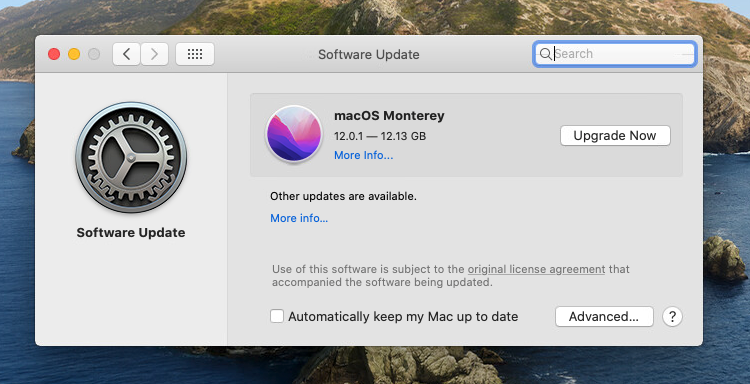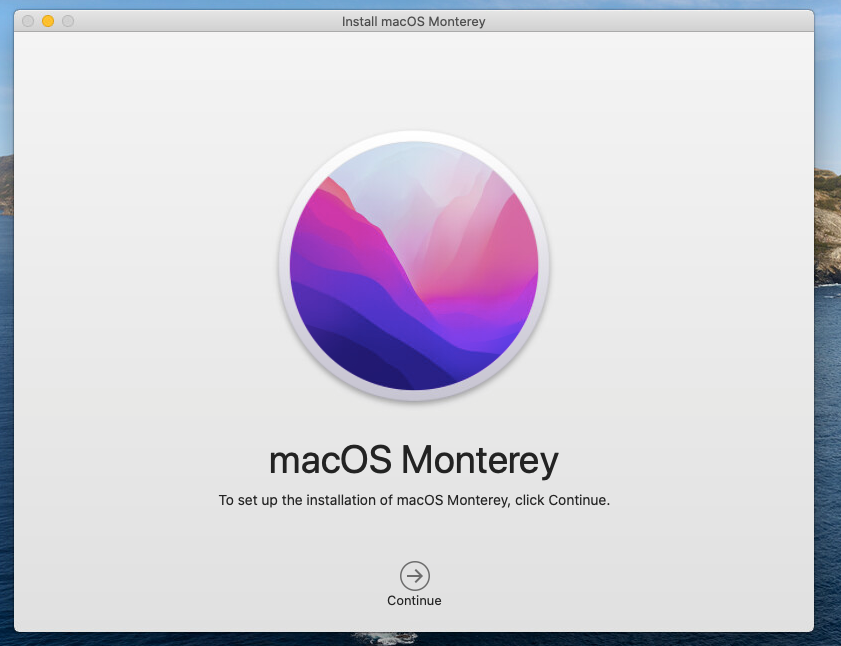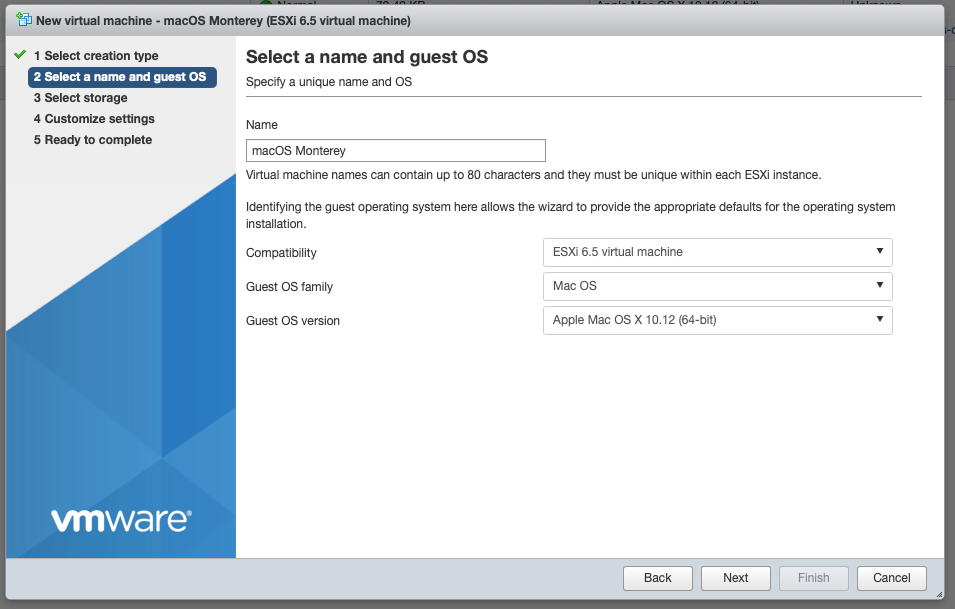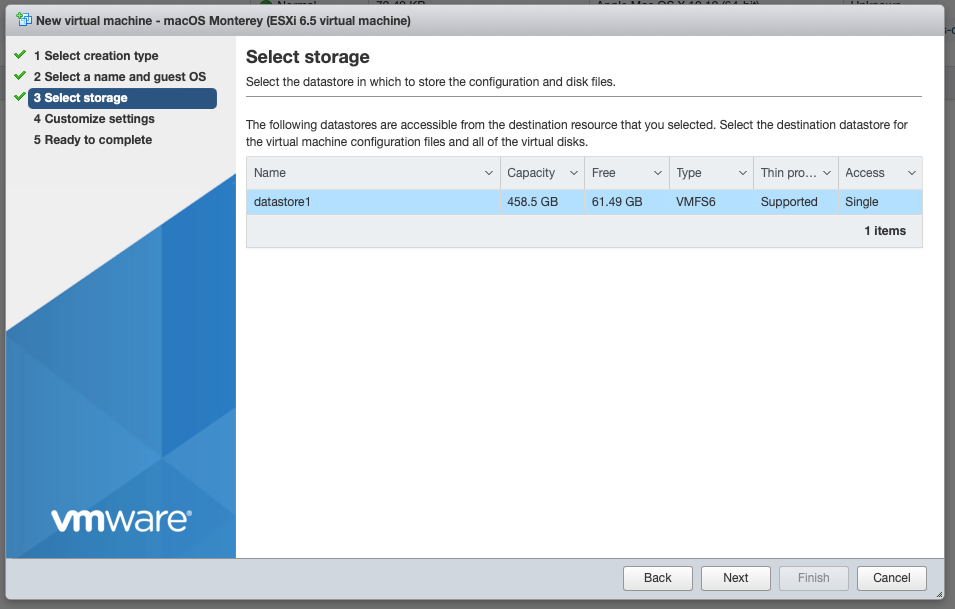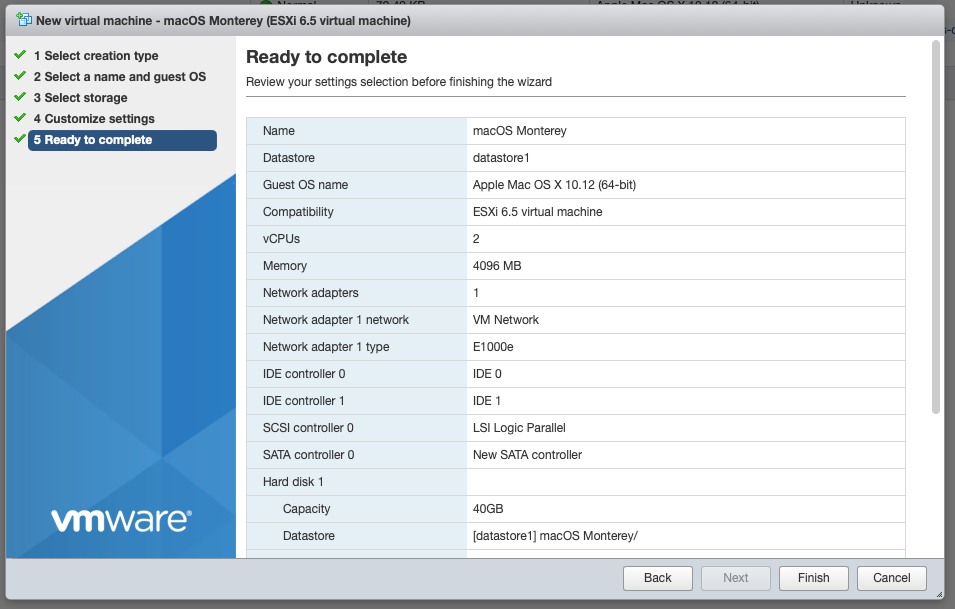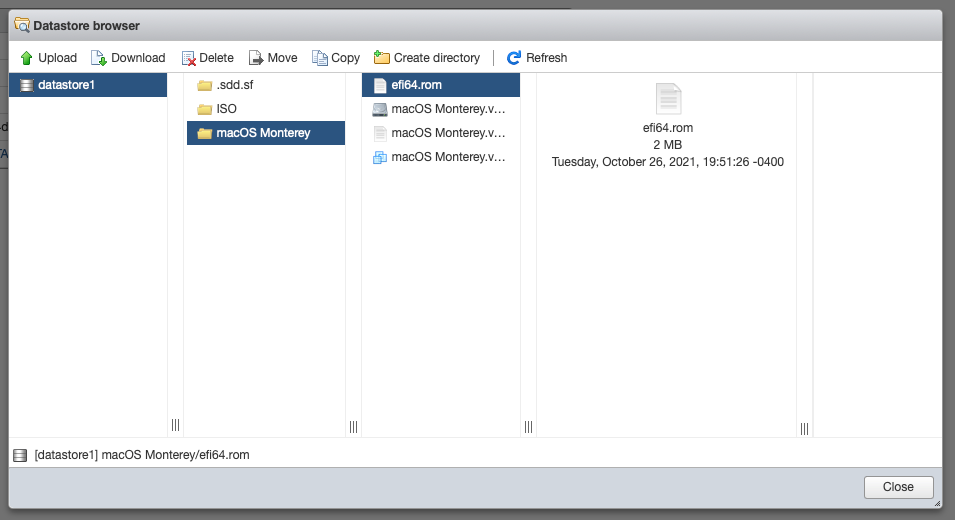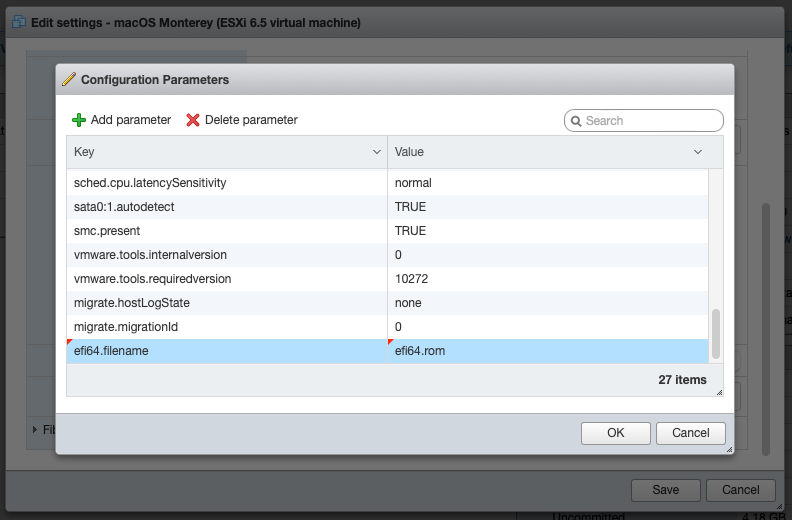Difference between revisions of "Virtualizing macOS Monterey"
| Line 50: | Line 50: | ||
#: [[File:Monterey_guide_6.png]] | #: [[File:Monterey_guide_6.png]] | ||
#: [[File:Monterey_guide_7.png]] | #: [[File:Monterey_guide_7.png]] | ||
| − | # | + | # In the list of virtual machines select your new VM and click '''Edit''' |
# Expand the '''CD/DVD Drive''' section, change the type to '''Datastore ISO file'', select your Monterey ISO file, click '''Select''', then check '''Connect at power on''' | # Expand the '''CD/DVD Drive''' section, change the type to '''Datastore ISO file'', select your Monterey ISO file, click '''Select''', then check '''Connect at power on''' | ||
# Under '''Video Card''' change the type to '''Specify custom settings''' then change '''Total video memory''' to 128 | # Under '''Video Card''' change the type to '''Specify custom settings''' then change '''Total video memory''' to 128 | ||
| Line 56: | Line 56: | ||
Don't power on your new virtual machine just yet! There is one more step before you can install macOS. | Don't power on your new virtual machine just yet! There is one more step before you can install macOS. | ||
| + | |||
| + | === Fixing EFI/APFS support === | ||
| + | The EFI firmware included in ESXi 6.x does not support APFS so it must be replaced. | ||
| + | This process is not complex but I have not written a guide for it yet. For now please follow the instructions located here: https://ericfromcanada.github.io/output/2019/macos-catalina-vmware-esxi-6.html | ||
| + | Save the resulting file as <code>efi64.rom</code> | ||
| + | <br /> | ||
| + | <br /> | ||
| + | Once you have your new EFI firmware file the VM must be told to use it. | ||
| + | # Upload the <code>efi64.rom</code> file to your '''datastore''' in the same folder as the virtual machine's files then click '''Close''' | ||
| + | #: [[File:Monterey_guide_8.png]] | ||
| + | # Select your virtual machine from the list then click '''Edit''' | ||
| + | # Click '''VM Options''' then scroll down and expand the '''Advanced''' section. Scroll down further to '''Configuration Parameters''' and click '''Edit Configuration''' | ||
| + | # At the top click '''Ad parameter''' | ||
| + | # Double click on the new row and clear the text that says '''Click to edit key'''. Enter <code>efi64.filename</code> in its place. | ||
| + | # Double click on '''Click to edit value''' and clear the text. Enter <code>efi64.rom</code> | ||
| + | # Click '''OK''' to close the window, then click '''Save''' to complete the configuration. | ||
| + | #: [[File:Monterey_guide_9.png]] | ||
| + | |||
| + | === Installing macOS Monterey === | ||
| + | Power on your virtual machine and the macOS Monterey installer should start. | ||
| + | [[File:]] | ||
Revision as of 00:03, 27 October 2021
Looking to virtualize the recently released macOS Monterey? Then this is the guide for you, read on!
Contents
Before you start
There are a few requirements before we get started. You will need:
- An Intel based Apple computer running a recent version of macOS like Catalina or Big Sur that is capable of running, but has not yet been upgraded to Monterey.
- An Apple computer running a recent of VMware ESXi. Running macOS in a virtual machine on Apple hardware is the only way to adhere to the user agreement. For the purposes of this guide I'll be using a 2013 Mac Pro running VMware ESXi 6.5.0 Update 2 (Build 8294253)
- An evaluation copy of VMware Workstation Pro for Windows(v15 or later)
- At least 28GB of free space on your mac
Getting the Monterey installer
- On your mac that has not yet been upgraded to Monterey open System Preferences then navigate to Software Update. You should be prompted to download or upgrade to Monterey.
- After the download is complete simply close the installer. Do not start the installation process!
Creating a bootable disc image
Just like Big Sur the process of creating install media is a bit different than previous macOS releases.
- Create a disc image to house the installer. For macOS Monterey 12.0.1 the image must be at least 13685 MB in size.
hdiutil create -o monterey.dmg -size 13685m -volname macOSMonterey -layout SPUD -fs HFS+J
- Attach the volume
hdiutil attach monterey.dmg -noverify -mountpoint /Volumes/macOSMonterey
- Use the createinstallmedia tool inside the Monterey installer to make the disc image into a bootable macOS installer. This process will take a couple minutes.
sudo /Applications/Install\ macOS\ Monterey.app/Contents/Resources/createinstallmedia --volume /Volumes/macOSMonterey --nointeraction
- Detach the volume. Note that the volume name and mount point changed during the process.
hdiutil detach /Volumes/Install\ macOS\ Monterey
- Convert the resulting dmg file to a cdr
hdiutil convert monterey.dmg -format UDTO -o monterey.cdr
- Finally, rename the cdr to iso.
mv monterey.cdr monterey.iso- The dmg image can now be used to create a bootable USB stick or simply deleted.
- Upload your new bootable ISO image to your datastore in VMware ESXi
Creating the Virtual Machine
- In the ESXi console click Create /Register VM
- Select Create a new virtual machine then click Next
- Select the highest Compatibility possible. In my case ESXi 6.5 virtual machine
- Select Mac OS under Guest OS Family
- Select the highest supported macOS version possible. In my case Apple Mac OS X 10.12 (64-bit)
- Enter a name for the virtual machine then click Next
- Select the datastore to use for virtual machine storage then click Next
- Make adjustments to the CPU count but be sure to only use two sockets. E.g to have 4 CPU cores you can either choose 4 CPU and 4 Cores per Socket or 2 CPU and 2 cores per socket.
- For Memory 2GB is the minimum recommended. The more the better though!
- For the Hard Disk 40GB is a good start, adjust to fit your needs.
- Select the appropriate Network
- Do not change any other settings at this point, they will be changed later. Click Next then Finish
- In the list of virtual machines select your new VM and click Edit
- Expand the CD/DVD Drive' section, change the type to Datastore ISO file, select your Monterey ISO file, click Select, then check Connect at power on
- Under Video Card change the type to Specify custom settings then change Total video memory to 128
- Click Save
Don't power on your new virtual machine just yet! There is one more step before you can install macOS.
Fixing EFI/APFS support
The EFI firmware included in ESXi 6.x does not support APFS so it must be replaced.
This process is not complex but I have not written a guide for it yet. For now please follow the instructions located here: https://ericfromcanada.github.io/output/2019/macos-catalina-vmware-esxi-6.html
Save the resulting file as efi64.rom
Once you have your new EFI firmware file the VM must be told to use it.
- Upload the
efi64.romfile to your datastore in the same folder as the virtual machine's files then click Close - Select your virtual machine from the list then click Edit
- Click VM Options then scroll down and expand the Advanced section. Scroll down further to Configuration Parameters and click Edit Configuration
- At the top click Ad parameter
- Double click on the new row and clear the text that says Click to edit key. Enter
efi64.filenamein its place. - Double click on Click to edit value and clear the text. Enter
efi64.rom - Click OK to close the window, then click Save to complete the configuration.
Installing macOS Monterey
Power on your virtual machine and the macOS Monterey installer should start. [[File:]]
